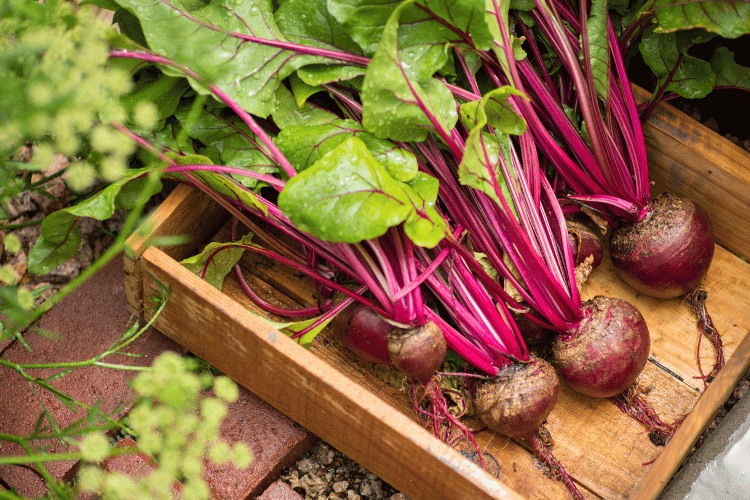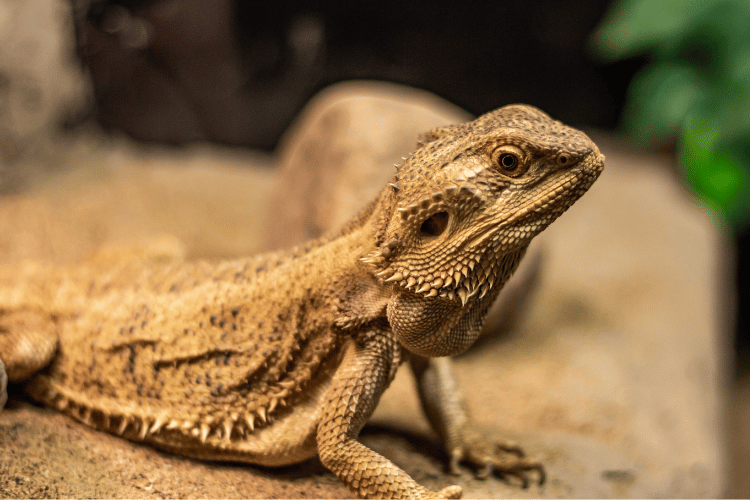As omnivores, reptiles can eat a wide range of vegetables. Yet, many bearded dragon owners hesitate before indulging their pets in a sweet, earthy beetroot.
So, can bearded dragons eat beets?
While occasional bites aren’t incredibly harmful, beets aren’t an ideal food. That’s partly because they’re oxalate-rich, but there are more issues to consider.
What are those concerns? Do they apply to beet greens as well? Let’s find out all the details before you throw a beet slice into your lizard’s tank!
What’s Wrong With Beets?

We wouldn’t recommend making beets a staple for pet beardies. Why? There are three core concerns that bearded dragon caretakers should know.
1. Oxalate Content Reduces Key Nutrient Absorption
Beetroots (and their green leaves) contain oxalates, and too much of those aren’t good for our scaly buddies.
What exactly are oxalates? In simple terms, they’re plant compounds that love to latch onto minerals like calcium as food passes through a reptile’s gut.
When oxalates, like oxalic acid, bind and drag out essential nutrients this way, you risk problems like calcium deficiency and poor bone health.
Leafy greens like spinach and Swiss chard also contain these sneaky oxalates. So it’s better to serve these fresh vegetables as occasional treats.
2. Disproportionate Calcium and Phosphorus Contents
Beets have a poor calcium-to-phosphorus (Ca:P) ratio, with high phosphorus content and little calcium.
What’s the worst that could happen if they eat too many food items with unbalanced Ca:P ratios?
Well, without enough calcium, your bearded dragon can face metabolic bone disease (MBD), fractures, seizures, and other scary symptoms.
We’ll explore the specifics of MBD later in the article. But for now, just know that beets make it extra tricky for beardies to get sufficient calcium.
3. Potential Impaction/Choking Hazard
Finally, the firm texture of raw beetroot can pose a potential choking hazard or impaction risk.
As many bearded dragon owners know, the food pieces should never be larger than the space between their eyes.
So, if served at all, pieces of beetroot must be chopped into itty bitty, bite-sized morsels. Even then, it’s smart to monitor for gagging or signs of obstruction.
What’s Up With Metabolic Bone Disease?
Earlier, we touched on the scary term “MBD,” Now, let’s break it down.
Unbalanced Diets Compromise Bone Health
MBD stems from long-term nutritional imbalances, mainly diets high in phosphorus but deficient in calcium. The condition also arises when pet lizards lack appropriate UVA and UVB exposure, which they need to synthesize critical Vitamin D.
Without enough bone-building nutrients, our pet reptiles can’t maintain healthy skeletal development. That’s why baby bearded dragons (under two years old) are particularly at risk.
Recognizing the Symptoms
What warning signs suggest your companion suffers from MBD? Look for:
- Jaw swelling or distortion
- Twitching and abnormal movements
- Low activity level
Over time, the disease can also cause bone fractures and seizures.
Seeking Treatment
The good news? Catching MBD early and correcting dietary imbalances may resolve mild cases. Prescription vitamin and calcium supplements can get struggling beardies back on their feet.
Why Some People Choose to Feed Their Bearded Dragons Beets
While beets pose some risks, some reptile owners wonder: could there still be health benefits to feeding beardies a tiny bit of fresh beetroot every now and then?
Well, the red plant material isn’t without its nutritional benefits.
- Moisture Content: Beets are around 87% water. This high water content could help keep your bearded dragon hydrated.
- Source of Fiber: Getting enough fiber supports healthy digestion and bowel movements in reptiles.
- Source of Vitamins: Beets provide forms of vitamin A and vitamin C.
In tiny portions, a bearded dragon owner might rotate beets into the diet for moisture content, fiber, minerals, or vitamins. But as we’ll explore next, precautions are still needed.
3 Tips for Feeding Your Bearded Dragon Beetroot

If you’re going to give your beardie beets, the least you can do is take some precautions.
Here are three simple tips to keep in mind with this dietary source:
1. Do It Sparingly
Bearded dragons don’t necessarily need beets to stay healthy. So make this vibrant veggie an occasional thing, not a regular menu item.
For the majority of the time, you’ll want to make better, beardie-safe dietary choices. Aim for a variety of vegetables and feeder insects.
2. Prepare Beets the Right Way
You’ll serve the beets raw, but it’s still good to give them a good scrub and peel the skin. No lazy washing here—you want to remove chemical pesticide residues.
Then, slice the beets into small, bite-sized pieces or cubes.
3. Monitor Your Pet
Keep a close eye on your bearded dragon after he eats the treat. If he acts differently or seems uncomfortable, something’s up.
Runny or smelly poo? Bloody vomit? Rush to the exotic animal doc ASAP! Catching any problems early helps keep your precious pet safe.
It’s worth noting that beets might turn the little fellow’s poop blood-orange colored. That’s not a major issue as long the poop isn’t actually bloody.
Beets vs. Beet Greens: Best Pick for the Bearded Dragon Diet
So, beetroots are risky veggie picks. But what about vibrant beet greens instead? How do they compare nutritionally?
| Nutritional Components | Raw Beets | Raw Beet Greens |
| Ca:P Ratio | 1:1.4 | 2.8:1 |
| Water Content | 87.6 | 91 |
| Protein | 1.61 | 2.2 |
| Carbohydrates | 9.56 | 4.33 |
| Total Fat Content | 0.17 | 0.13 |
| Total Dietary Fiber | 2.8 | 3.7 |
The leaves of beet greens still contain oxalate (around 610 milligrams for every 100 grams).
However, the leaves’ Ca:P ratio is closer to the correct balance. So, you could use the greens as an occasional treat for your bearded dragon. Just don’t overdo it.
Final Thoughts
Beets wouldn’t be our go-to in a bearded dragon’s balanced diet. The fact is, the dark red beets have problematic levels of oxalate plus a poor calcium-phosphorus balance.



